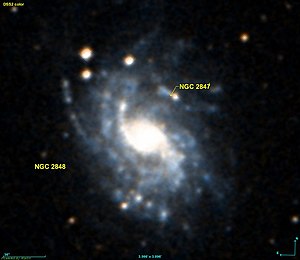NGC 2848
| Galaxy NGC 2848 |
|
|---|---|

|
|
| AladinLite | |
| Constellation | Water snake |
|
Position equinox : J2000.0 , epoch : J2000.0 |
|
| Right ascension | 09 h 20 m 09.8 s |
| declination | -16 ° 31 ′ 34 ″ |
| Appearance | |
| Morphological type | SAB (s) c: / HII |
| Brightness (visual) | 11.8 mag |
| Brightness (B-band) | 12.5 mag |
| Angular expansion | 2.5 ′ × 1.5 ′ |
| Position angle | 40 ° |
| Surface brightness | 13.1 mag / arcmin² |
| Physical data | |
| Redshift | 0.006791 ± 0.000013 |
| Radial velocity | 2036 ± 4 km / s |
|
Stroke distance v rad / H 0 |
(82 ± 6) · 10 6 ly (25.2 ± 1.8) Mpc |
| history | |
| discovery | William Herschel |
| Discovery date | December 31, 1785 |
| Catalog names | |
| NGC 2848 • PGC 26404 • MCG -03-24-007 • IRAS 09178-1618 • 2MASX J09200989-1631334 • GC 1829 • H III 488 • h 587 • HIPASS J0920-16 • HOLM 128A • LDCE 618 NED004 | |
NGC 2848 is a bar-spiral galaxy with extensive star formation regions ( including the region NGC 2847 ) of the Hubble type SBc in the constellation Hydra south of the ecliptic . It is estimated to be 82 million light-years from the Milky Way and about 60,000 light-years across.
The galaxies NGC 2811 and NGC 2851 are located in the same area of the sky .
The Type II supernova SN 1994L was observed here.
The object was discovered by Wilhelm Herschel on December 31, 1785 .
